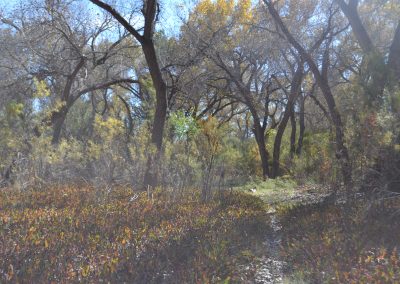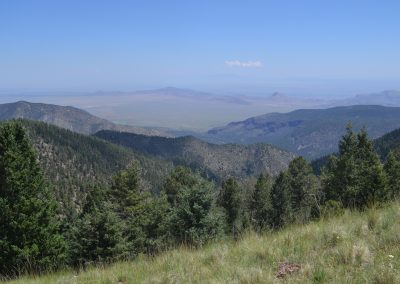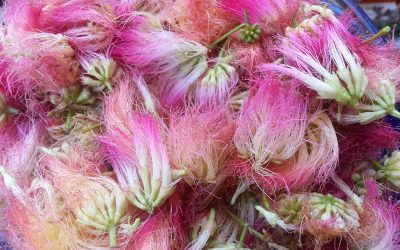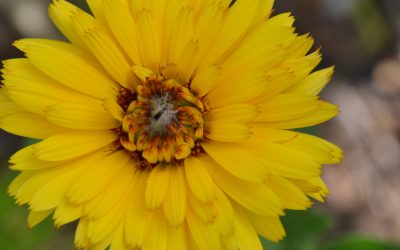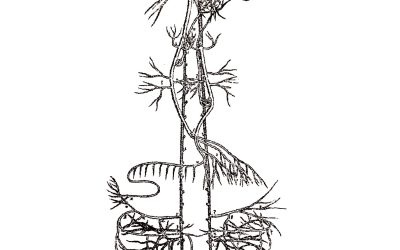The Beauty of the Bioregional Approach to Your Herbal Practice
by Dara Saville
There are many ways to practice herbalism including a multitude of traditions all over the world, each with their own plants that form the core of that herbal path. No matter what traditions we are trained in, we can apply what we learn to the plants and the land around us. Every bioregion has plants that are heating or cooling, moistening or drying, calming or stimulating. Every area has plants that strengthen vital organs and body systems and run the full list of medicinal actions. Using our local plants we can create well-matched formulas for anyone with nearly any health situation. After all, these plants have co-evolved with people and have a long history of interconnection with those who have lived along side them. Aside from the actual medicine-making, there is more to glean from this way of practice. There is an opportunity for something deeper, something more profound that comes through spending time with plants in their native habitats or in the garden. We have the opportunity to understand them intimately, to share our lives, and to receive the gifts that come through relationship.
What is Bioregional Herbalism?
Every art, skill, or science has rules. Herbalists have a great degree of freedom within their profession due in part to the large number of paradigms and traditions within which we can practice. The bioregional approach is just one of many. When we choose this path, however, we can embrace the set of rules that apply here. The word ‘rules’ may provoke an unpleasant response, especially for those of us who are not inherently rule-followers. If we choose to do our work adhering to the rules of bioregionalism, we are accepting a challenge to accomplish our goals using only the plants available to us locally. This can of course also be extended to include all of the ingredients in our herbal products, not just herbs. I will be the first to admit that I do use some base ingredients that are not produced in my local area. It is important to remember though that even in ancient times, some items were acquired through trade from distant locations and were considered precious resources. For example I could use Jojoba or even tallow, but I prefer to use coconut oil and olive oil for my infused oils. As for the herbs, I have rarely found a reason to look too far from home. Following this rule of bioregionalism encourages our own creativity and intellectual curiosity. It pushes us to know each plant as thoroughly as possible and to work with them in new and different ways. Ultimately it drives us to new edges within our practices and ourselves.

In order to accept this challenge of following the bioregional rule, we need to specify what constitutes a bioregion. Generally speaking a bioregion is an area that is defined by natural borders such as a watershed or mountain ranges and includes one or more ecosystems with characteristic flora and fauna. We could define a bioregion more broadly as a system of landscapes with both natural layers and human elements that reciprocally affect one another and create a unique combination of characteristics to define a whole place. Furthermore, we find systems of bioregions, one within another, like tree rings. The Rio Grande Valley is within both the Southern Rocky Mountains and Desert Basin and Range, for example. Every one of us lives within a bioregion and to live bioregionally means that we are aware of the natural and cultural history of our area and we commit to living in a way that takes into consideration the resources available to us where we live.
What Are The Most Important Tenets of Bioregional Herbalism?
First you must know the locals. Befriend the weeds, the commoners, and get to know the not-so-commoners, too (who are they and why are they not-so-common?). Grow what you can in your own garden and make these readily available plants from the wilds and your yard the foundation of your practice. Truly knowing the plants around you goes well beyond identification and medicinal uses and takes you into more intimate kinds of knowledge. It leads us to an understanding of their life cycle, their lineage, their personal experience, and even sharing consciousness. The practice of bioregional herbalism keeps at its heart the plants found in the surrounding environment. It makes us look beyond our textbooks to see the teachers waiting for us in the suburban yards, urban parks, and wild lands beyond. Seeking relationships with local plants fosters a deep and powerful connection to our regional landscapes, allowing us to become more acutely aware of the inter-being of plants, people, and the land. Herbalism quickly crosses over from practical to spiritual when you feel the life force of your medicine and its inter-connection with you and everything else in the cosmos. Looking deeply into a plant, the exchange is intimate and the effect is penetrating. Like an ancient hunter who dons animal regalia in ceremony, you become one with the plant. You are the medicine that you seek. These realizations come from sitting with plants. They come from working with the plants that are living and evolving with us, sharing the same habitat, entwined with our own life experiences.

Showy Milkweed – Asclepias speciosa
In addition to knowing the plants, it is critical to understand the dynamics of the larger landscape to which those plants are connected. Knowing the natural and cultural history of your area helps you to understand the microcosm in front of you when you are looking deeply into a plant. It also helps us to see the interconnection between plants and people in your area and the reciprocal relationship between people and the land over time. When we enter the wilderness seeking relationships with plants there is always an imperative to know what?s going on in the broader picture. To know wild plants more deeply and to harvest them responsibly we must understand the way they function in their ecosystems and also how those ecosystems are connected to the larger physiographic region. Looking at Yerba Mansa (Anemopsis californica) as an example, we can clearly see the importance of understanding landscape dynamics, the personal history of a plant, and its relationship to the land as well as its relationship to us. You may come upon a large stand of Yerba Mansa and feel immediately captivated by this plant as its stunning visual beauty and pungent aroma grab hold of you and pull you in. If you don?t know the bigger story, you may get a false sense of security, abundance, and stability. This plant has been a significant part of the Rio Grande Valley for millions of years, carpeting large areas of the floodplain and associated wetlands. The aromatic oils of the roots altered the soil chemistry facilitating the growth of other plants and dispersing the waters and microbes of this slow-moving ecosystem. During the last 150 years, however, water diversion, urbanization, and flood control measures have transformed the riparian zones of the Southwest and the desert bosque environments upon which Yerba Mansa depends for its survival have become some of the most threatened ecosystems anywhere. When we understand what is happening in the larger system, we know that this plant’s habitat is in major decline. This knowledge changes the way we approach and work with the plant. Seeing that large stand of Yerba Mansa is no longer something to take for granted, it becomes something to cherish and protect.

Yerba Mansa – Anemopsis californica
Now that we have become familiar with the plants and the land, we are ready to consider our own role within all of this. That means we must alter our practice according to the first two tenets. Harvesting a wild plant is not a casual thing. It’s a sacred act that connects us to the plant’s history and its future. In fact, we are playing a role in determining what happens next. The actions we take and the attitudes we adopt are shaping that future right now. When we enter the wilderness we become a part of it, a functioning part of the ecosystem. We must ask ourselves what role will we play in that system of interactions and interconnections. As I have just mentioned, understanding that an ecosystem is threatened inspires us to interact with the plants that live around us differently. Likewise when you know that a plant has a life span many times longer than yours, it also changes the way you feel about those elders. Have you ever hiked amongst the Bristlecone Pines (Pinus longaeva) or through a Creosote (Larrea tridentata) plain? If you have then you probably know these plants may live for thousands of years acquiring the kind of wisdom we humans can only dream of. This awareness will change the way we relate to the plants and it will bring something intangible and eternal to our medicine. Similarly, when you hike in the same places for many years and observe the changes in plant populations over long periods of time, you make different decisions about harvesting and may even chose to work with different plants. When you know the local history of use for a plant and the role it has played in other local societies and cultural groups, it affects the way you work with those plants in your own formulations. Part of the bioregional herbal practice must always include in-depth knowledge of the landscape to which we belong. Acquiring this knowledge and developing this understanding of the local dynamics between people, plants, and the land will ultimately shape the way you practice, influence the way you feel about yourself as an herbalist, and contribute to the kind of person that you are.

Creosote – Larrea tridentata
Why Practice This Way?
Accepting the challenge of the bioregional herbal practice comes with both practical and more profound rewards. Using what we have available to us everyday, we can care for others and ourselves in a way that is affordable, sustainable, and empowering. Working with locally obtained herbs from our gardens and wild places and making our own medicines dramatically reduces the cost of natural healthcare. It also means that we avoid industrial harvesting, long distance shipping, and increasing demands on vulnerable plant populations for the most popularly consumed herbs in the worldwide market. This kind of homegrown and handcrafted healthcare also leads to personal empowerment. We are in-tune and connected to our own bodies as we forge health and wellbeing from the lands that we tend and love.
Bioregional herbalism also enables us to become more connected to the land and more deeply rooted in our home. Engaging in this kind of practice shepherds us into oneness with the plants as we incorporate them into our everyday lives. The plants, in turn, bring us into harmony with the habitat that we share. The medicines that we make are more than healing remedies; each sip of tea or drop of tincture may become a prayer to a plant that we know or a way of honoring the deepest kind of connection that binds all life together. Living this way creates the opportunity to combine daily experiential learning with fact-based research and to join these two types of knowledge together for a broad spectrum and in-depth understanding of the place where we live. Through this process we come to see more clearly the dynamics unfolding all around us and within us. We are part of our local ecosystem, inseparable from it, sharing the same fate ultimately. A bioregional practice provides an avenue for us to be more informed about our own habitat and to decide more deliberately what role we will play in that ecosystem. We can contribute to the health of the land by protecting vulnerable plant populations and becoming a force for conservation and restoration.

In addition to making connections with plants and taking the time to understand what is happening in our local landscapes a bioregional practice will inevitably lead us to introspection and an exploration of what lies inward. While seeing our place in the larger whole is important, knowing ourselves more deeply is also a worthy journey. Plants can help us discover what has been lost within the deep woodlands of ourselves. When we work closely with a particular selection of plants we have the opportunity to develop relationships with them. The gifts of relationship lead us to new avenues in our work with plants, facilitate the process of self-discovery, and may become a catalyst for more profound realizations. I have taken lessons from the mountain, the desert plains, the riparian forests of the valley, and even my own backyard medicine garden. These are the places I go to grow myself and humbly seek the wisdom of antiquity. All of these places are connected, as is all the life that inhabits these places. Walking in the Bosque I have felt that interconnection with Cottonwood elders and the young porcupines sleeping in the crooks of their branches. I have heard from the forest, the mountain, the mesa, and the river that all life is inter-being and whatever I do to restore plants and their habitats ultimately builds vitality within myself.

How Can You Make This Kind Of Practice Your Own?
Bioregional herbalism and its myriad of gifts are accessible to everyone. There are several things you can do, no matter where you live, to bring this practice to life. Study with and learn from the local mentors available to you: people, plants, and the land itself. Learn not just about plants, but also their habitats, how people have interacted with the land and how they have worked with the plants in your area. Integrate the natural and cultural history of your bioregion into your herbal practice and make your work a continuation of, and a complement to, all that came before. In doing this, it is imperative to get out there in the mountains, valleys, estuaries, canyons, riparian zones, and in your garden. Spend time with the plants where they are. What are they offering you in this moment? What will they bring to your medicine? How can you create a relationship that is truly reciprocal? Most of us are eager to harvest, but what can we give back? Through this closeness with plants and their habitats, we come to understand our role in our local environment. We see what we must do in order to facilitate the health of the land and therefore our own interconnected wellness. Get involved in projects that will give back to the plants and bring new meaning to your life as an herbalist. Many (if not all) wild areas are under pressure from urbanization, resource extraction, habitat degradation, water management, climate change, and more. There is a need everywhere for people to stand up and speak for the plants and the land upon which they and we depend. Get involved in a project that speaks to you or start one yourself. When we have acquired an in-depth understanding of our local bioregion?s history, we can see more clearly what we need to do to safeguard it for the future.
In practicing herbalism with our local plants we find the best medicine for us right now. We discover the beauty of bioregional herbal practice: sustainable and affordable medicine that connects us to our local landscape, protects vulnerable plant populations for the future, returns us to our place in the natural world, and ultimately helps us to discover ourselves. Becoming more deeply connected to our local bioregion and the plants and animals that share it, we have the opportunity to bridge the past and the future by giving the land what it needs right now while receiving the gifts of respectful harvest. In living our lives this way, we will find our wild selves in harmony with our own habitats and we will make medicine with the power of the land behind us.
This essay was originally published as: Saville, Dara. (2015). The Beauty of a Bioregional Approach to Your Herbal Practice. Plant Healer Quarterly, 5(4), 29-34.



